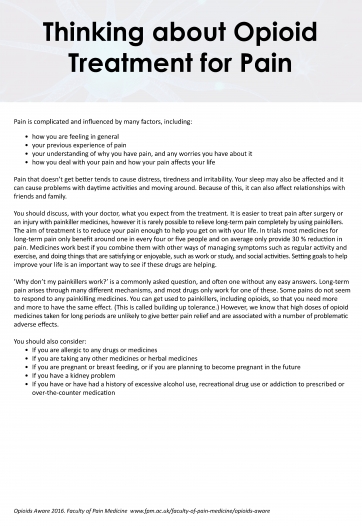Thinking about opioid treatment for pain
Pain is complicated and influenced by many factors, including:
- how you are feeling in general
- your previous experience of pain
- your understanding of why you have pain
- any worries you have about your pain
- how you deal with your pain
- how your pain affects your life
Pain that doesn’t get better tends to cause distress, tiredness and irritability. Your sleep may also be affected and it can cause problems with daytime activities and moving around. Because of this, it can also affect relationships with friends and family.
You should discuss, with your doctor, what you expect from the treatment. It is easier to treat pain after surgery or an injury with painkiller medicines, however it is rarely possible to relieve long-term pain completely by using painkillers. The aim of treatment is to reduce your pain enough to help you get on with your life. In trials most medicines for long-term pain only benefit around one in every four or five people and on average only provide a 30 % reduction in pain. Medicines work best if you combine them with other ways of managing symptoms such as regular activity and exercise, and doing things that are satisfying or enjoyable, such as work or study, and social activities. Setting goals to help improve your life is an important way to see if these drugs are helping.
Why don’t my painkillers work? is a commonly asked question, and often one without any easy answers. Long-term pain arises through many different mechanisms, and most drugs only work for one of these. Some pains do not seem to respond to any painkilling medicines. You can get used to painkillers, including opioids, so that you need more and more to have the same effect.: This is called building up tolerance. However, we know that high doses of opioid medicines taken for long periods are unlikely to give better pain relief and are associated with a number of problematic adverse effects.

